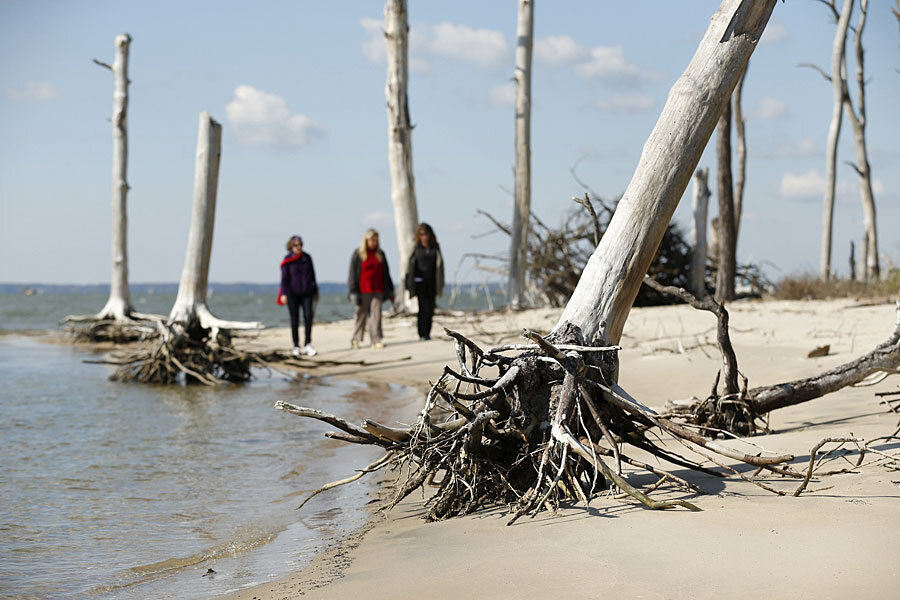Costs rise faster than water, according to sea level rise study
Loading...
Recent research on climate change has emphasized the fact that sea levels are rising quickly, and can have dangerous and costly impacts on human infrastructure.
Researchers are discovering just how costly climate change can be. On Monday, climate scientists at the Potsdam Institute of Climate Impact Research published a new study in the journal Natural Hazards and Earth System Sciences that found that the economic costs of sea level rise increase more quickly than sea levels themselves.
“Our study illustrates that the complexity of climate change, adaptation, and flood damage can be disentangled by surprisingly simple mathematical functions,” said Markus Boettle, the lead author of the Potsdam Institute’s study, in a press release, “to provide estimates of the average annual costs of sea-level rise over a longer time period.”
As study co-author Jürgen P. Kropp explained, scientists created mathematical models to predict the costs of sea level rise around the world.
“We provided an analytical mathematical description which helps to assess expected damage for a certain time span according to different sea-levels,” said Dr. Kropp in an email interview with The Christian Science Monitor.
“This methodology is applicable to any place worldwide and therefore produces comparable cost assessments,” he says.
According to their model, costs are not proportional to sea level changes. If, for example, sea levels rise ten centimeters and cause a billion dollars of damage, a twenty centimeter rise would not cause two billion dollars worth of damage, but much more.
Models for Copenhagen, Kropp writes, predict that “for a sea level rise of 11 cm within the period 2010-2050, [there will be] an expected cost of 1.1 billion Euros. For a sea level rise of 25 cm in the same city and the same time span the costs are more than fivefold. This is the key message!”
Predictions vary, but most climate models estimate that sea levels will rise between one and two meters (3 to 6 feet) by 2100, while sea levels only rose 30 cm (1 foot) in the 20th century.
Climate scientist Dr. Dan Kammen at the University of California, Berkeley, who was not involved in the study, told the Monitor that part of the challenge of rising sea levels is that many countries have their infrastructure concentrated along coastlines. Not only are cities like New York, Boston, San Francisco, Los Angeles, and more located along the coast, but Internet cables, sewer lines, piping, and other infrastructure are also vulnerable to rising sea levels.
Already, coastal cities and towns have been hurt by rising sea levels. Dr. Ben Horton, a researcher at the Rutgers Institute of Marine and Coastal Sciences, told the Monitor that 40 to 50 thousand people in New Jersey would not have been flooded by superstorm Sandy if not for rising sea levels.
The Mississippi delta loses a chunk of land the size of a football field every day, says Dr. Horton, because of rising sea levels.
If sea levels rise a meter by 2100, Manhattan dwellers will be up to their ankles in sea water.
To respond to rising sea levels, countries must both adapt to changes and mitigate the causes of sea level rise. If countries reduce carbon dioxide output enough that it peaks by 2040 or 2050, says Horton, sea level rise by 2100 could be half as severe as if the world continues with “business as usual.”
“The urgency is dire,” says Horton.
The difference between no response and a concerted effort to reduce emissions and slow sea level rise, he describes as "an economic watershed, the difference between having a prosperous society and a society in chaos."
With this in mind, the scientists behind the new study say people must understand the economic impacts of sea level rise, as well as the environmental.
“Climate change is a massive social injustice,” says Horton. Not only can poorer communities or countries not afford to adapt and mitigate with advanced technology in the same way that developed countries can, but developing countries are frequently at greatest risk when sea levels rise.
In Bangladesh, which could lose one third of its land mass if sea levels continue to rise, agriculture is vital to the national economy. If rising sea levels are not mitigated, Bangladesh’s agriculture, which includes lowland crops like rice, will be threatened.
According to Horton, the recently crafted Paris agreement includes provisions to protect developing nations, including establishing a fund for the guardianship of developing nations as they adapt to climate change.






